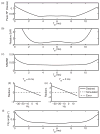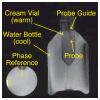Maximum linear-phase spectral-spatial radiofrequency pulses for fat-suppressed proton resonance frequency-shift MR Thermometry
- PMID: 19780177
- PMCID: PMC2795148
- DOI: 10.1002/mrm.22118
Maximum linear-phase spectral-spatial radiofrequency pulses for fat-suppressed proton resonance frequency-shift MR Thermometry
Abstract
Conventional spectral-spatial pulses used for water-selective excitation in proton resonance frequency-shift MR thermometry require increased sequence length compared to shorter wideband pulses. This is because spectral-spatial pulses are longer than wideband pulses, and the echo time period starts midway through them. Therefore, for a fixed echo time, one must increase sequence length to accommodate conventional spectral-spatial pulses in proton resonance frequency-shift thermometry. We introduce improved water-selective spectral-spatial pulses for which the echo time period starts near the beginning of excitation. Instead of requiring increased sequence length, these pulses extend into the long echo time periods common to PRF sequences. The new pulses therefore alleviate the traditional tradeoff between sequence length and fat suppression. We experimentally demonstrate an 11% improvement in frame rate in a proton resonance frequency imaging sequence compared to conventional spectral-spatial excitation. We also introduce a novel spectral-spatial pulse design technique that is a hybrid of previous model- and filter-based techniques and that inherits advantages from both. We experimentally validate the pulses' performance in suppressing lipid signal and in reducing sequence length compared to conventional spectral-spatial pulses.
(c) 2009 Wiley-Liss, Inc.
Figures








References
-
- Meyer CH, Pauly JM, Macovski A, Nishimura DG. Simultaneous spatial and spectral selective excitation. Magn Reson Med. 1990 Aug;15(2):287–304. - PubMed
-
- de Zwart JA, Vimeux FC, Delalande C, Canioni P, Moonen CT. Fast lipid-suppressed MR temperature mapping with echo-shifted gradient-echo imaging and spectral-spatial excitation. Magn Reson Med. 1999;42(1):53–59. - PubMed
-
- Weidensteiner C, Quesson B, Caire-Gana B, Kerioui N, Rullier A, Trillaud H, Moonen CTW. Real-time MR temperature mapping of rabbit liver in vivo during thermal ablation. Magn Reson Med. 2003;50(2):322–330. - PubMed
-
- Zur Y. Design of improved spectral-spatial pulses for routine clinical use. Magn Reson Med. 2000 Mar;43(3):410–420. - PubMed
Publication types
MeSH terms
Grants and funding
LinkOut - more resources
Full Text Sources
Medical

